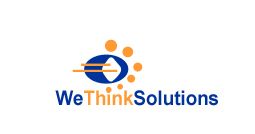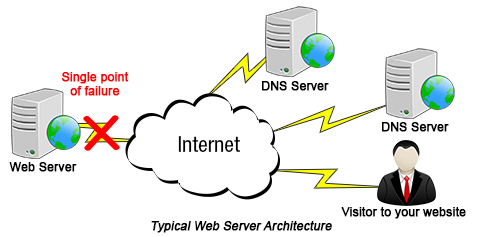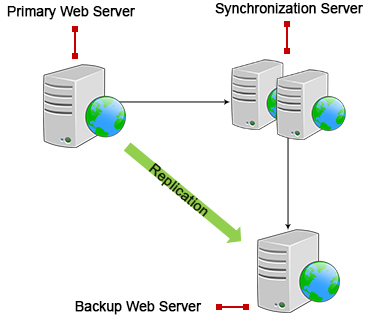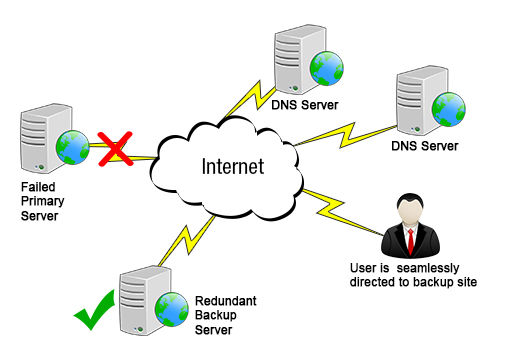- Home
- About Us
- Websites
- Performance Based SEO
- Web Marketing
- Contact Us
- Clients
- Blog
 |
|
|
Website Replication and Failover
Professional organizations understand the importance of having a reliable website. When your website is down, this sends a highly visible message to your customers, employees and investors that something has gone wrong within your organization. Chances are, the problem is outside of your control but that doesn't matter to your site's visitors.
The good news is that this problem can be easily overcome by putting a failover system in place. Systems fail for a variety of reasons that cannot always be prevented. The fact is that most websites are architected with an inherent single point of failure as depicted here:

In this typical system, if the webserver that is hosting your website fails for any reason, such as a power outage, disruption in internet service, denial of service attack, etc., your website visitors will be shown an error page such as the following:

We can solve this problem by eliminating the single point of failure through the implementation of a site replication and failover strategy. Under this scenario, when your website fails, your visitors are automatically and seamlessly directed to a redundant backup replica of your site so that there is no disruption in your end-user experience.
There are four main aspects to our website failover solution:
- Website Replication
- Status Monitoring
- Failover Redirection
- Recovery Handling
Website Replication
 Website replication involves ensuring that an up-to-date redundant copy of your website is constantly available. As you make changes to your primary website, these changes must be readily and consistently applied to your backup site so that the two versions of the sites are constantly in sync. In most cases, we can achieve adequate website replication without requiring any internal access to files, server code or proprietary content. Our replication servers simply crawl your website in much the same way as Google and other search engines harvest the contents of your site.
Website replication involves ensuring that an up-to-date redundant copy of your website is constantly available. As you make changes to your primary website, these changes must be readily and consistently applied to your backup site so that the two versions of the sites are constantly in sync. In most cases, we can achieve adequate website replication without requiring any internal access to files, server code or proprietary content. Our replication servers simply crawl your website in much the same way as Google and other search engines harvest the contents of your site.
The crawl frequency of our replication servers is configurable and can be adapted to align with the volatility of the sites being replicated. Sites that change often must be crawled more frequently to minimize out-of-date conditions.
Status Monitoring

In order to detect when your primary website has failed, it is necessary to communicate with the site on a regular and frequent basis. At the same time, we must ensure that the monitoring, itself, does not impact the performance or reliability of your site.
It is not uncommon for websites to have periodic, temporary service disruptions during periods of peak demand. The monitoring process must discern between temporary or one-time failures and longer term problems that warrant initiation of the failover plan and activation of the backup (replica) site.
Failover Redirection

Whenever the Status Monitor detects that the site being monitored has failed, it is necessary to direct the website users to the backup website server. This should happen seamlessly and in a very timely manner (generally within a couple of minutes of the initial failure). The failover step notifies the DNS servers associated with the failed domain that the website pages are to be served from an alternate IP address (belonging to the Backup Server). Web visitors will not even be aware that this has happened since the only noticeable difference is generally just the speed with which the pages are served (the backup site is usually faster that the primary server).
Recovery Handling
Monitoring of the primary web server will continue even after the DNS has been updated to point to the backup server. Once it has been determined that the primary site is up and responding normally, the DNS will be updated again to revert back to the original site. Again, this happens seamlessly so users will not be aware that they have switched back to the primary site.
Minimal Impact on Original Website Configuration
Our approach does not require us to have any internal access to your existing server or website application. You, as the domain administrator, simply need to update the Name Server entries associated with your domain to activate our failover system. If, for some reason, you decide that failover is no longer a requirement you can revert these Name Server entries back to the original settings to deactivate our failover solution.
Pricing
Failover pricing can vary based on the complexity of the site to be replicated. For most "brochure" style websites, we charge a fixed monthly amount as well as a variable fee that is based on the number of pages in the website requiring failover support. The following table shows these monthly fees:
| Website Pages | Monthly Base Price |
Additional Monthly Cost Per Page |
| 1-100 | $20 | 0.50 |
| 101-1000 | $50 | 0.25 |
| 1001-10000 | $100 | 0.10 |
| 10000+ | Call for pricing |
|
|||||||
| Home Business Websites clients Performance Based SEO PPC Advertising Professional Directories Conventional Marketing Contact Us | |||||||
| © 1998 - 2025 We Think Solutions, Inc. | Privacy Policy | Sitemap | ||||||